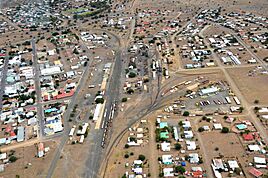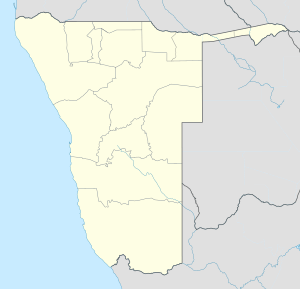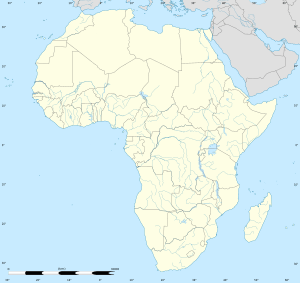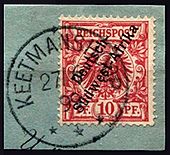Keetmanshoop facts for kids
Quick facts for kids
Keetmanshoop
ǂNuǂgoaes
Swartmodder
|
||
|---|---|---|
|
City
|
||
|
Clockwise from top: Keetmanshoop church, Keetmanshoop airport, Colonial ruins, Aerial view of Keetmanshoop, Colonial post office
|
||
|
||
| Motto(s):
Laborando vincimus
|
||
| Country | ||
| Region | ǁKaras Region | |
| Constituency | Keetmanshoop Urban | |
| Established | 14 April 1866 | |
| Area | ||
| • Total | 202.4515 sq mi (524.3469 km2) | |
| • Land | 202.4515 sq mi (524.3469 km2) | |
| • Water | 0 sq mi (0 km2) | |
| Population
(2023)
|
||
| • Total | 27,862 | |
| • Density | 137.6231/sq mi (53.1366/km2) | |
| • Density | 103.6/sq mi (40/km2) | |
| Time zone | UTC+2 (SAST) | |
| Climate | BWh | |
Keetmanshoop is a town in southern Namibia. It is located in the ǁKaras Region. The town sits on the main railway line that connects Windhoek to Upington in South Africa. Keetmanshoop is named after Johann Keetman. He was a German businessman who helped the town financially.
Contents
History of Keetmanshoop
Before it was called Keetmanshoop, the area had two other names: ǂNuǂgoaes and Swartmodder. Both names mean "Black Marsh". This tells us there was a natural spring in the area.
The first European settler, Guilliam Visagie, arrived here in 1785. In February 1850, a group called the Kharoǃoan clan settled here. They were also known as the Keetmanshoop Nama.
In 1860, the Rhenish Missionary Society started a mission in the area. Their goal was to teach the local Nama people about Christianity. The first missionary, Johann Georg Schröder, arrived on April 14, 1866. This date is now considered the founding day of Keetmanshoop. The mission station was named after Johann Keetman. He was a German trader and director of the Rhenish Missionary Society. He gave money to support the mission, even though he never visited the place himself.
Natural Wonders Near Keetmanshoop
Keetmanshoop is close to two special quiver tree forests. One of these forests is a national monument. It is a very popular place for tourists to visit in Namibia.
The town is also near the Giant's Playground. This is a natural rock formation that looks like huge giants stacked the rocks. These rocks are called dolerite and were formed about 180 million years ago.
You can also find important fossils near Keetmanshoop. These fossils are from an ancient reptile called Mesosaurus. This reptile lived a very long time ago, during the Early Permian period. Fossils of Mesosaurus have been found in both southern Africa and South America.
Important Buildings and Structures
The Rhenish Missionary Church was built in 1895. Today, it also has a museum inside. This church was made a historic monument in 1978. It is a famous landmark in the town. The church has a unique look, combining Gothic style with African stone. This makes it one of the most beautiful buildings in Namibia.
Other important buildings include the Schützenhaus (a club house built between 1905 and 1907). The railway station building was built in 1908. The Imperial Post Office, built in 1910, is now the Keetmanshoop tourist information center.
Close to Keetmanshoop, you can find the Naute Dam and the Neckartal Dam. The Neckartal Dam is the largest dam in Namibia.
The J. Stephanus Stadium is in Keetmanshoop. It is the home field for Fedics United F.C., a football team that plays in the Namibia Premier League.
Keetmanshoop is also an important center for farming Karakul sheep. These sheep are known for their special wool.
Notable People
- Anthony Antoncich (1917–1998), a Royal Air Force pilot, was born in Keetmanshoop.
Geography
Climate
Keetmanshoop has a hot desert climate. This means it has very long and hot summers. The winters are cold. The town gets very little rain, only about 159 millimeters (about 6 inches) each year.
Keetmanshoop is one of the sunniest places on Earth! It gets over 3,870 hours of sunshine every year. That's about 10.7 sunny hours every day. The average temperature for the year is about 21.1 °C (70.0 °F). The average high temperature is 28.8 °C (83.8 °F), and the average low is 13.3 °C (55.9 °F). The weather here is mostly sunny, dry, and warm all year.
| Climate data for Keetmanshoop | |||||||||||||
|---|---|---|---|---|---|---|---|---|---|---|---|---|---|
| Month | Jan | Feb | Mar | Apr | May | Jun | Jul | Aug | Sep | Oct | Nov | Dec | Year |
| Mean daily maximum °C (°F) | 34.8 (94.6) |
34.0 (93.2) |
32.2 (90.0) |
28.8 (83.8) |
25.0 (77.0) |
21.7 (71.1) |
21.3 (70.3) |
23.5 (74.3) |
27.2 (81.0) |
30.1 (86.2) |
32.4 (90.3) |
34.5 (94.1) |
28.8 (83.8) |
| Mean daily minimum °C (°F) | 19.0 (66.2) |
19.3 (66.7) |
17.8 (64.0) |
14.4 (57.9) |
10.4 (50.7) |
7.0 (44.6) |
6.4 (43.5) |
7.5 (45.5) |
10.7 (51.3) |
13.7 (56.7) |
15.7 (60.3) |
17.6 (63.7) |
13.3 (55.9) |
| Average precipitation mm (inches) | 24 (0.9) |
42 (1.7) |
36 (1.4) |
15 (0.6) |
5 (0.2) |
2 (0.1) |
1 (0.0) |
1 (0.0) |
3 (0.1) |
6 (0.2) |
11 (0.4) |
13 (0.5) |
159 (6.1) |
| Average relative humidity (%) | 28 | 36 | 40 | 40 | 38 | 39 | 36 | 31 | 27 | 24 | 24 | 25 | 32 |
| Mean monthly sunshine hours | 353 | 300 | 312 | 306 | 304 | 287 | 305 | 323 | 319 | 343 | 348 | 370 | 3,870 |
| Percent possible sunshine | 84 | 82 | 82 | 89 | 91 | 91 | 93 | 93 | 89 | 87 | 86 | 86 | 88 |
| Source: Tabulation of Climate Statistics for Selected Stations in Namibia | |||||||||||||
See also
 In Spanish: Keetmanshoop para niños
In Spanish: Keetmanshoop para niños













